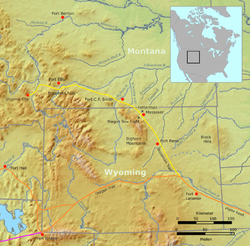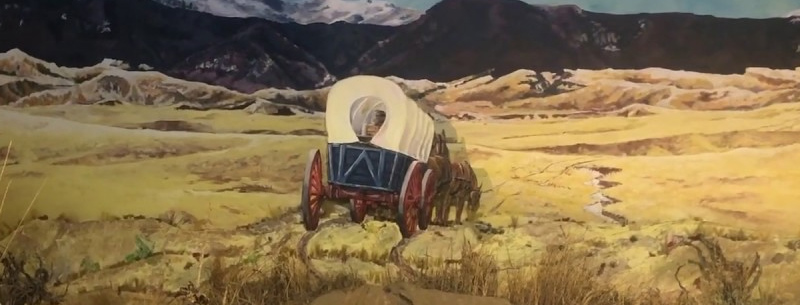The Bozeman Trail was first established as the shortest route to the Montana goldfields from Ft. Fetterman. Back in the 1860′s, when gold was struck, the trail was blazed for fortune seekers, miners, and settlers. And, of course, U.S. Army soldiers were sent there to protect. The proposed route wasn’t a popular choice, in fact, Jim Bridger, the great mountain man, and trailblazer, strongly suggested other pathways. Bridger knew that the trail, first navigated in 1863 by John Bozeman, would run right through Indian hunting grounds. The Sioux and Crow nations would be most affected by the Bozeman Trail.

The Bozeman Trail was a shortcut to the newly discovered goldfields of Montana Territory. Cutting through the heart of Indian country, it provoked a clash of cultures that exploded into warfare, destruction, and tragedy. It was a singular road that changed this part of the American West forever.
The Bozeman Trail turned north from the Platte River near Ft. Fetterman, up the Powder River, along the eastern slope of the Bighorn Mountains and into Montana. And for five years, it would become an extremely busy and terribly dangerous thoroughfare. Many a battle during the Indian Wars were fought along with the Bloody Bozeman.
There were a handful of forts built along the trail but soon abandoned. Two of the bloodiest battles of the era were fought on the Bozeman Trail, the Ft. Fetterman Massacre and the Wagon Box Fight. It was one of many trails carved across Wyoming during the Great Emigration and Gold Rush Days, but the Bloody Bozeman Trail will always be remembered as the most dangerous and volatile of them all.
The Bozeman Trail was an offshoot of the Oregon Trail, a shortcut to the newly discovered goldfields of Montana Territory. Cutting through the heart of Indian country. It became a flash point for a clash of cultures that would explode into warfare, destruction, and tragedy.
Pumpkin Buttes
The Indians called the buttes “wagamu paha”, meaning gourd hills. The Sioux used the site for tribal ceremonies and put Pumpkin Buttes to good use as a perfect lookout during battles with settlers along the Bozeman Trail. There are hundreds of tipi rings on and around the buttes that prove that Native Americans lived and worshipped here for centuries.
Pumpkin Buttes not only served as a welcome landmark along the Bloody Bozeman Trail, but it also became a hideout for famed outlaw “Big Nose” George Parrott. In the 1950s, uranium was discovered near Pumpkin Buttes, which would generate a lot of ill will between prospectors and stockmen. There were only a few small mines that worked in the area.
Bozeman Trail Resources
The Bloody Bozeman – True West Magazine
truewestmagazine.com/the-bloody-bozeman
The Bloody Bozeman From Wyoming’s Fort Laramie travesty to Montana’s Alder Gulch goldfields that inspired the trail. May 13, 2013 Candy Moulton Trails across the West in the mid-1800s crisscrossed Indian lands, often displacing the people who had been living on the land for generations.
The Bozeman Trail – A Violent Path to the Gold Fields …
www.legendsofamerica.com/bozeman-trail
Of all the overland trails blazed during the westward movement, the Bozeman Trail ranks as one of the most violent, contentious and ultimately failed experiments in American frontier history.. Though the trail is named for John Bozeman, an immigrant from Georgia, who was said to have blazed the route, in actuality Native Americans had been using the route as a travel corridor for centuries.
The Bloody Bozeman: #ThisWeekInWYHistory | County 17
county17.com/2019/01/23/the-bloody-bozeman-thisweekinwyhistory
At 500 miles in length, the “Bloody Bozeman” broke off from the Oregon Trail at current-day Casper and ran through the heart of Indian country, shaving weeks off of travel time. According to wyohistory.org, the trail gained its name from John Bozeman, a Georgia native who came west during the Pikes Peak gold rush.
